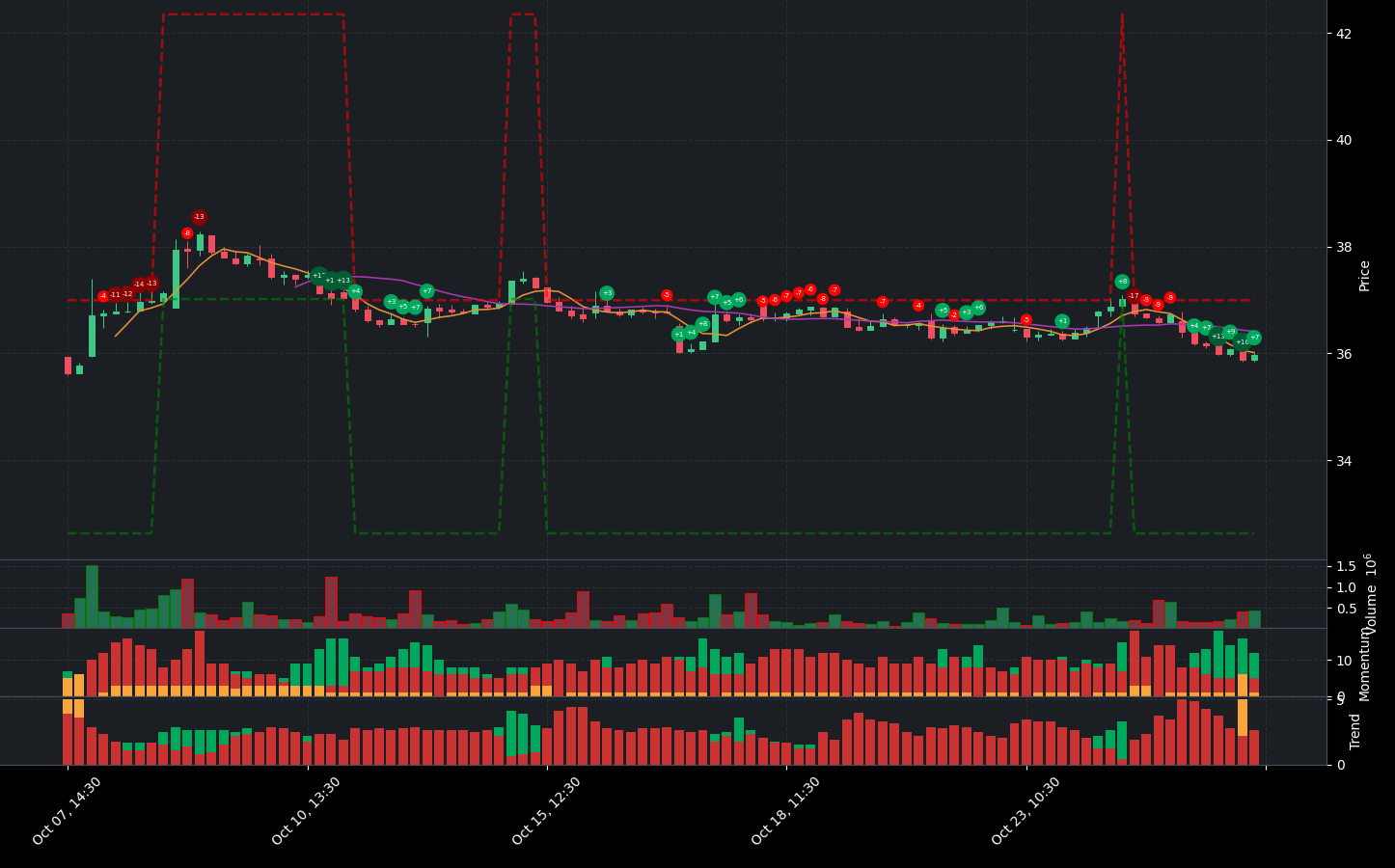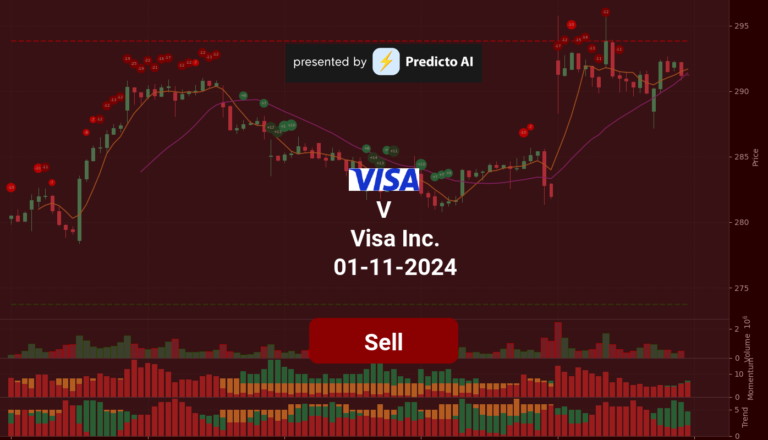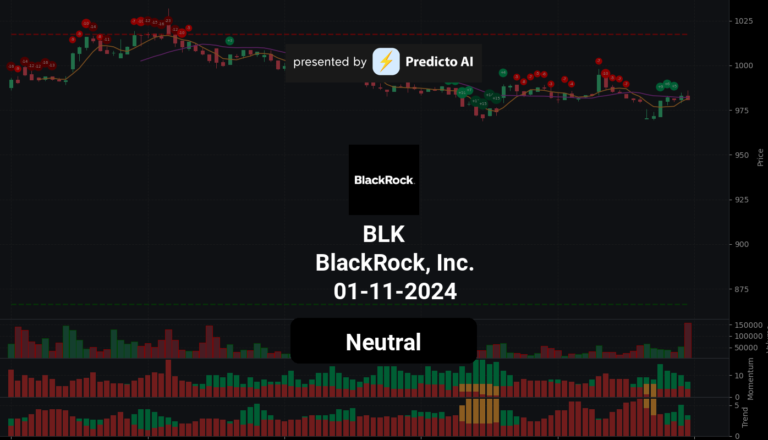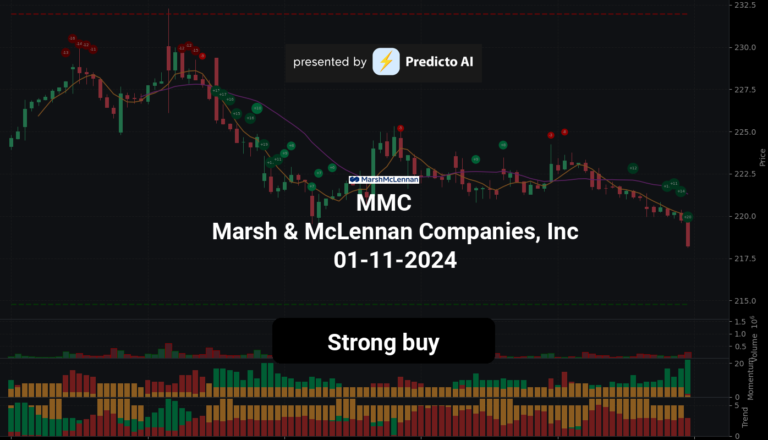BAX Stock Analysis: A Mixed Outlook Ahead!
🔴 Recommendation: Baxter International Inc. (BAX) is currently rated as a strong buy, but investors should proceed with caution due to a complex mix of indicators and financial health concerns.
📈 Key Highlights:
Momentum Indicators: Positive signals from StochRSI and WaveTrend suggest potential buying opportunities as the stock appears oversold.
Revenue Growth: Total revenue of $3.81 billion reflects a year-over-year growth of 6.12%, indicating moderate expansion.
Institutional Ownership: High institutional ownership at 92.55% suggests strong backing from large investors, providing some stability.
⚠️ Caution Flags:
Negative Net Income: Recent net income was negative at $-314 million, raising significant concerns about profitability.
High Debt Levels: Average net debt stands at $11.52 billion, which could impact financial flexibility and sustainability.
Supply Chain Challenges: Ongoing supply shortages, particularly in IV supplies, pose operational risks that could hinder growth.
As we delve deeper into the analysis, we will explore the price trends, technical indicators, financial health, valuation metrics, and more to provide a comprehensive view of BAX’s potential in the coming months. Stay tuned for the detailed breakdown! 👇
BAX Price Analysis

| Positive Momentum Signals | Negative Momentum Signals | Hold Momentum Signals |
|---|---|---|
|
|
|
| Positive Trend Signals | Negative Trend Signals | Hold Trend Signals |
|---|---|---|
|
|
BAX stock presents a complex picture for investors, characterized by both promising and cautionary signals. Currently rated as a strong buy, the stock shows several positive momentum indicators, including a StochRSI indicating oversold conditions and a WaveTrend suggesting a potential bottom. These factors may signal an opportunity for investors looking to capitalize on a rebound.
However, caution is warranted as the stock is closer to resistance, which could limit upside potential in the short term. On the trend front, the On-Balance Volume (OBV) is increasing alongside high volume, and the MACD has shown a positive histogram crossover, indicating bullish momentum. Yet, the stock is currently below the middle band of its trading range and is in a downtrend, which suggests that while there may be short-term buying opportunities, the overall trend remains bearish.
The technical indicators also reveal that BAX is below both the 50-day and 200-day Exponential Moving Averages (EMAs), reinforcing the bearish trend. The Supertrend indicator is also bearish, indicating that the stock is trading below this key level. These factors collectively suggest that while there may be oversold conditions, the broader trend is not favorable.
In summary, while BAX stock has some attractive buying signals, the prevailing bearish trends and proximity to resistance necessitate a cautious approach. Investors may consider a buy position, but should remain vigilant and prepared for potential volatility as the stock navigates its current technical landscape.
BAX Fundamental Analysis
BAX’s recent financial performance presents a mixed picture, with several concerning indicators overshadowing some positive aspects. The company reported a negative net income of $-314 million, raising significant concerns about its profitability. This decline in net income year-over-year suggests potential challenges in maintaining future profitability.
On a more positive note, BAX achieved a total revenue of $3.81 billion, reflecting a year-over-year growth of 6.12%. This moderate growth indicates that the company is generating significant sales, although the negative net income raises questions about its ability to convert revenue into profit effectively. The operating margin is reported at an exceptionally high 100.00%, but this figure warrants further scrutiny to assess its sustainability, especially given the negative net profit margin of -8.24%.
The company’s valuation metrics present a somewhat favorable outlook, with a forward P/E ratio of 11.38 suggesting potential undervaluation compared to the market. Additionally, a price-to-sales ratio of 1.24 indicates a reasonable valuation relative to sales. However, the concerning profit margins and negative net income overshadow these positive valuation indicators.
In terms of financial health, BAX faces challenges with a high average net debt of $11.52 billion and a debt-to-equity ratio of -3.12, indicating a high level of leverage that may be unsustainable. The current ratio of 1.23 suggests a healthy liquidity position, allowing the company to cover short-term liabilities, but the low cash to total assets ratio of 0.11 raises concerns about financial flexibility. Furthermore, the average tangible book value is negative at $-4.86 billion, which raises alarms about the company’s net worth.
On the cash flow front, BAX shows some positive signs with average capital expenditures of $678 million, indicating investment in growth and expansion. The net cash from financing is positive at $5.35 billion, suggesting successful capital-raising activities. Additionally, stock repurchases of $283 million could signal management’s confidence in the company’s future prospects.
Overall, while BAX exhibits some positive indicators such as revenue growth and reasonable valuation metrics, the negative net income and profit margins raise significant concerns about the company’s financial health and future profitability. Investors should approach BAX with caution, carefully weighing the risks against the potential for recovery in profitability.
Financial Health
🔴 Net Income for the most recent period was negative at $-314 million, raising concerns about the company’s profitability.
🔴 Year-over-year net income decreased, indicating potential challenges in future profitability.
🟢 Total Revenue for the most recent period was $3.81 billion, with a year-over-year revenue growth of 6.12%, suggesting moderate growth.
🔴 Operating Margin is exceptionally high at 100.00%, but this figure may require further scrutiny to understand its sustainability.
🔴 Net Profit Margin is negative at -8.24%, indicating difficulties in converting revenue into profit.
🔴 Average Dilution of earnings per share was $-314 million, suggesting significant impact from share-based compensation.
🔴 Net Interest Income was negative at $-85 million, indicating the company is paying more in interest than it earns on its assets.
🔴 Interest Expense was $104 million, which adds to the financial burden.
Valuation
🟢 Forward P/E ratio is 11.38, suggesting potential undervaluation compared to the market.
🟢 Price-to-Sales Ratio is 1.24, indicating reasonable valuation relative to sales.
Growth and Profitability
🟢 Revenue Growth of 6.12% is positive, indicating some growth momentum.
🔴 Profit Margins are concerning at -8.24%, reflecting challenges in profitability.
🔴 Operating Cash Flow is not explicitly provided, but the negative net income raises concerns about funding operations.
Shareholder Information
🟢 Average Ordinary Shares Outstanding is 508 million, indicating a stable shareholder base.
🔴 Average Treasury Shares at 175 million could indicate management’s confidence, but also raises questions about cash reserves.
Income Statement
🔴 Net Income is negative at $-314 million, indicating a loss.
🟢 Total Revenue of $3.81 billion shows the company is generating significant sales.
🔴 Year-over-year revenue growth of 6.12% is positive, but the negative net income raises concerns.
🟢 Operating Margin of 100.00% suggests efficient operations, but requires further analysis.
🔴 Net Profit Margin of -8.24% reflects challenges in profitability.
Balance Sheet
🔴 Average Net Debt is high at $11.52 billion, which could impact financial flexibility.
🔴 Debt-to-Equity Ratio of -3.12 suggests a high level of leverage, which may be unsustainable.
🟢 Current Ratio of 1.23 indicates a healthy liquidity position, suggesting the company can cover short-term liabilities.
🔴 Cash to Total Assets Ratio is low at 0.11, indicating limited financial flexibility.
🔴 Average Tangible Book Value is negative at $-4.86 billion, raising concerns about the company’s net worth.
Cashflow
🟢 Average Capital Expenditures of $678 million suggest investment in growth and expansion.
🟢 Net Cash from Financing is positive at $5.35 billion, indicating capital raising activities.
🟢 Stock Repurchases of $283 million can be a positive signal, potentially boosting earnings per share.
Overall, while there are some positive indicators such as revenue growth and a reasonable valuation, the negative net income and profit margins raise significant concerns about the company’s financial health and future profitability.
BAX News Analysis
Baxter International Inc. (BAX) is facing a mixed outlook based on recent news. While there are positive developments such as participation in a healthcare conference, significant challenges like supply shortages and operational issues could hinder growth. Investors should weigh these factors carefully.
🟢 Baxter International (BAX) will present at the UBS Global Healthcare Conference, which could enhance visibility and investor interest in the company.
🔴 The medical supply chain is currently grappling with shortages, particularly in IV supplies, which could impact Baxter’s operations and revenue.
🔴 Hospitals are facing an IV fluid shortage that may affect surgeries for weeks, indicating a critical supply chain issue that could hurt Baxter’s business.
🔴 A recent article discusses the impact of Hurricane Helene on the medical supply chain, suggesting that external factors are complicating Baxter’s operational environment.
🔴 The growing biosimilars business is mentioned in relation to Abbott (ABT), indicating competitive pressures that could affect Baxter’s market position.
🔴 There are discussions about whether Baxter is a good value stock, reflecting uncertainty in its current valuation amidst these challenges.
BAX Holders Analysis
The financial health of BAX presents a mixed outlook for the next month. While there are positive indicators, the low insider ownership and high institutional concentration raise some concerns.
🟢 BAX has a **high institutional ownership** at **92.55%**, indicating strong interest from large investors, which can provide stability and support for the stock price. This level of institutional backing suggests confidence in the company’s long-term prospects.
🔴 However, the **insider ownership is very low at 0.38%**, which may indicate a lack of confidence from company management. This could lead to questions about the alignment of interests between management and shareholders.
🟡 The number of institutional holders is substantial at **1215**, reflecting a diversified ownership structure. This can mitigate risks associated with any single investor’s actions, but it also means that significant selling by institutions could lead to increased volatility.
🟡 Recent insider transactions show no significant purchases, which could be interpreted as a lack of confidence in the stock’s near-term performance. The absence of insider buying might suggest that insiders do not see immediate value at current price levels.
🔴 The stock has experienced some volatility, and the high institutional ownership could lead to rapid price movements if large holders decide to sell. This could create uncertainty for retail investors.
BAX Analyst Ratings
The analyst ratings for BAX show a mixed sentiment, with a total of 2 strong buy ratings, 4 buy ratings, 9 hold ratings, 1 sell rating, and no strong sell ratings. This indicates a cautious outlook among analysts. 🟡 Over the past three months, the ratings have remained relatively stable, with no significant upgrades or downgrades, suggesting that analysts are uncertain about the stock’s near-term performance.
🟢 The recent actions from firms like Citigroup, Goldman Sachs, and JP Morgan maintaining a neutral stance further reinforce this sentiment. However, the downgrade from Morgan Stanley from overweight to underweight raises some concerns about the stock’s potential.
Given the current analyst ratings and the lack of strong bullish sentiment, it is likely that BAX will experience moderate performance over the next month. The stock may fluctuate within a range of 1-3% based on current market conditions and analyst sentiments.
BAX Economic Analysis
Based on the US economic and market data:
🔴 The unemployment rate has increased to 4.3%, up from 4.1% in the previous month, indicating a potential slowdown in the labor market which could negatively impact consumer spending and, consequently, demand for Baxter’s products.
🟡 Retail sales have shown a slight increase to 627,510, but this is not substantial enough to suggest strong consumer confidence or spending growth.
🟢 The GDP growth rate remains relatively stable, suggesting that the overall economy is not in decline, which is a positive sign for Baxter’s long-term prospects.
🔴 The increase in the Monthly Treasury Yield to 4.25% may lead to higher borrowing costs for companies, including Baxter, which could impact their profitability and investment capacity.
🟡 The overall market indices such as NASDAQ and S&P 500 are currently showing mixed signals, indicating uncertainty in the market which may affect investor sentiment towards healthcare stocks like Baxter.
In summary, while there are some positive indicators, the increase in unemployment and treasury yields presents challenges that could hinder Baxter’s stock performance in the short term. The forecast for the next month suggests a cautious approach, with potential price fluctuations around the current level of 35.97, possibly ranging between 34.00 and 37.00.
Disclaimer
Investors may consider the AI predictions and news summaries as one factor in their investment decisions alongside their own research and risk tolerance.




